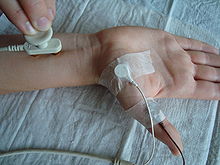

Medical uses | Technique | Patient risk
A nerve conduction study (NCS) is a medical diagnostic test commonly used to evaluate the function, especially the ability of electrical conduction, of the motor and sensory nerves of the human body.

Nerve conduction velocity (NCV) is a common measurement made during this test. The term NCV often is used to mean the actual test, but this may be misleading, since velocity is only one measurement in the test suite.
Nerve conduction studies along with needle electromyography measure nerve and muscle function, and may be indicated when there is pain in the limbs, weakness from spinal nerve compression, or concern about some other neurologic injury or disorder. Spinal nerve injury does not cause neck, mid back pain or low back pain, and for this reason, evidence has not shown EMG or NCS to be helpful in diagnosing causes of axial lumbar pain, thoracic pain, or cervical spine pain.
Nerve conduction studies are used mainly for evaluation of paresthesias (numbness, tingling, burning) and/or weakness of the arms and legs. The type of study required is dependent in part by the symptoms presented. A physical exam and thorough history also help to direct the investigation. Some of the common disorders that can be diagnosed by nerve conduction studies are:
The nerve conduction study consists of the following components
The nerve conduction study is often combined with needle electromyography.
Motor NCS are performed by electrical stimulation of a peripheral nerve and recording from a muscle supplied by this nerve. The time it takes for the electrical impulse to travel from the stimulation to the recording site is measured.
Sensory NCS are performed by electrical stimulation of a peripheral nerve and recording from a purely sensory portion of the nerve, such as on a finger.
F-wave study uses supramaximal stimulation of a motor nerve and recording of action potentials from a muscle supplied by the nerve. This is not a reflex, per se, in that the action potential travels from the site of the stimulating electrode in the limb to the spinal cord's ventral horn and back to the limb in the same nerve that was stimulated.
H-reflex study uses stimulation of a nerve and recording the reflex electrical discharge from a muscle in the limb. This also evaluates conduction between the limb and the spinal cord, but in this case, the afferent impulses (those going toward the spinal cord) are in sensory nerves while the efferent impulses (those coming from the spinal cord) are in motor nerves.
Nerve conduction studies are very helpful to diagnose certain diseases of the nerves of the body. The test is not invasive, but can be painful due to the electrical shocks. The shocks are associated with a low amount of electric current so they are not dangerous to anyone. Patients with a permanent pacemaker or other such implanted stimulators such as deep brain stimulators or spinal cord stimulators must tell the examiner prior to the study. This does not prevent the study, but special precautions are taken.
Cardiac pacemakers and implanted cardiac defibrillators (ICDs) are used increasingly in clinical practice, and no evidence exists indicating that performing routine electrodiagnostic studies on patients with these devices pose a safety hazard. However, there are theoretical concerns that electrical impulses of nerve conduction studies (NCS) could be erroneously sensed by devices and result in unintended inhibition or triggering of output or reprogramming of the device. In general, the closer the stimulation site is to the pacemaker and pacing leads, the greater the chance for inducing a voltage of sufficient amplitude to inhibit the pacemaker. Despite such concerns, no immediate or delayed adverse effects have been reported with routine NCS.
No known contraindications exist from performing needle EMG or NCS on pregnant patients. In addition, no complications from these procedures have been reported in the literature. Evoked potential testing, likewise, has not been reported to cause any problems when it is performed during pregnancy.
|
Page Content |